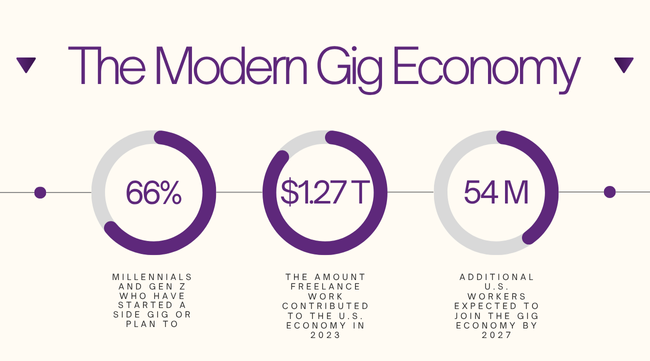
In a challenging economy and tight labor market, job seekers are redefining the structure of work. They’re saying goodbye to the constraints of a 9-to-5 schedule and embracing the flexibility of gig work, including temporary and contract jobs, freelance projects, and independent contracting. The gig economy is growing fast. Discover what’s fueling its rise and the benefits it presents for both workers and employers.
Historically, this trend has been cyclical, first gaining traction in the 1920s and resurfacing in the 1940s, 1990s, early 2000s, and again in the 2020s. Since the COVID-19 pandemic, Millennial and Gen Z workers have been leading the charge, and the momentum shows no signs of slowing. In 2023, 38% of U.S. workers (about 64 million people) performed freelance work in some capacity, contributing $1.27 trillion to the U.S. economy (Upwork). Furthermore, 66% of Gen Z and Millennials have either already started a side gig or plan to start one, and a substantial 54 million additional US workers are expected to join the gig economy within the next two years.
Why is the Gig Economy Growing?
So, what’s fueling this surge in gig work among Millennials and Gen Z? For many, it comes from a desire for autonomy and personal alignment. These generations value work that reflects their passions and gives them purpose, and they want to be in the driver’s seat. The ability to be their own boss, take ownership of their time, and build a career that aligns with their identity is a powerful motivator.
Flexibility is another key driver. These generations of workers are pushing back against rigid 9-to-5 schedules and office mandates, opting instead for work that can be done anytime, from anywhere. The traditional workday simply doesn’t make sense for a generation raised on instant access and digital tools that enable asynchronous productivity.
Of course, this shift wouldn’t be possible without the explosion of technology and social media. Advances in AI, automation, and digital platforms have made it easier than ever to find clients, promote services, and manage independent projects. Social media, in particular, has become a launchpad for building personal brands and monetizing skills, with 44% of gig workers relying on social media platforms for marketing and 32% finding social media to be a key factor in their success.
Economic pressures are also playing a significant role. In a tight labor market with consistently rising cost of living, many workers are turning to gig work to either supplement their full-time income or replace it altogether. And for many, it’s paying off: in 2020, 3 million U.S. gig workers earned over $100,000 annually, and by 2024, that number rose to 4.7 million (Oysterlink). As traditional job security becomes harder to find, gig work offers an alternative that’s not only viable but increasingly profitable.
The Business Case for Gig Work
The benefits of gig work aren’t one-sided. Organizations of all sizes can also leverage this trend to remain agile and competitive:
- Lower costs: Reduce expenses related to employee benefits, office space, onboarding, and long-term commitments.
- Workforce flexibility: Scale teams up or down based on business needs without the burden of layoffs.
- Access to global talent: Hire top-tier professionals with in-demand skills from anywhere, expanding beyond local talent pools.
- Project-based efficiency: Fill short-term gaps or bring in specialists for specific initiatives without long-term investment.

The gig economy is more than a trend. Millennials and Gen Z are fundamentally changing how we define work, driven by a desire for flexibility, autonomy, and purpose. For both workers and employers, the gig economy offers a modern solution for the ever-changing world of work.
